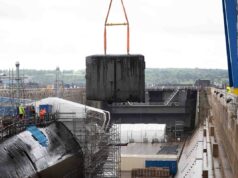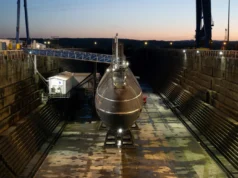Ferguson Marine’s future depends as much on people as on equipment or investment, and that is where new CEO Graeme Thomson placed much of his emphasis when we sat down for a chat in the future if the business.
He argued that the yard has lived with a level of scrutiny that has worn down confidence and narrowed the space for initiative. The task, as he sees it, is to rebuild the skills base, steady morale and develop leaders who can run a modern yard rather than one stuck in a cycle of crisis response.
This article, the third in our series, looks at the workforce Thomson inherited, the changes underway in training and development, and the effort to restore a sense of capability inside the organisation. Apprenticeships, planners, estimators, multi skilled operators and developing managers all feature in his account of what needs to be rebuilt for the yard to recover its rhythm.
Thomson described the impact of long running public scrutiny on the mindset within the yard. “There has been a cultural shift brought on by the criticism and the challenge that has been put to Ferguson’s,” he said. “When there is negativity in the media about the yard, people will start to believe that is the whole story.”
What he set out to re establish was belief in the skills already present. “One of the things I wanted to give back was give people confidence in their own capabilities and trust they are doing the right things,” he said. This was paired with a more structured approach to responsibility. People should take responsibility for their success and remember that every chapter is only part of the full story.
In practice, this has meant clearer role definition, more predictable reporting, and expectations around initiative. “We have made clarity of roles, driven accountability and put the right skills in the right areas,” he said. He told me of a need for employees to feel able to act. “Have the confidence to be innovative and solve problems rather than upward delegation or a lack of confidence.” The aim is straightforward: a workforce that trusts its own judgement again.
Developing early career specialists and strengthening core planning skills
One of the major workforce themes Thomson returned to was the need to grow planners, estimators and project control specialists from within. These are areas where the entire UK maritime sector struggles. “Planners in the marine industry is a real challenge,” he said. “So, we launched a trainee planners programme and moved people who have just come out of apprenticeship into training programmes.”
He intends to apply the same logic to estimating, where Ferguson Marine has sometimes relied on too few experienced staff. “We are looking to do the same with the estimating department and organically grow some of that capability,” he said. These are not peripheral roles. Thomson sees them as part of the long term backbone of the yard, ensuring that apprentices who want to move off the tools into analytical or supervisory functions have realistic paths to follow.
Apprenticeships as a foundation for the next generation
Apprenticeships featured heavily in Thomson’s thinking about the long term future of the yard. He presented them as the base layer of a workforce recovery that stretches beyond individual vessels or contract cycles. “We continue to recruit apprentices,” he said. “We have had a lot of success with apprentices in recent years, Scottish Apprenticeship of the Year, people going through the King’s Award.”
He wants the yard to offer more than a starting point. “We want people to come here, start and finish their apprenticeships, have confidence that the work will be there, support them doing their training,” he said. Consistency and visibility of work matter, partly because it gives the training investment meaning and partly because apprentices need a clear sense of long term direction to remain at the yard.
Thomson also discussed routes for those entering without a trade. “We have something here called multi skilled operators,” he said. He wants workers to move from unskilled to semi skilled, then on to skilled roles, and potentially into mature apprenticeships. It is designed to broaden access and build a wider base of potential tradespeople.
Culture, morale and the importance of work continuity
Asked about the morale in the yard, Thomson resisted simple answers so as not to downplay the issues. He compared morale to a coin with two distinct sides: one reflecting an air of optimism, while the other shows caution. “There’s excitement and enthusiasm; there’s real potential for a promising future,” he explained. People are noticing visible progress. They see the conversation shifting from crisis recovery to modernisation.
At the same time, the workforce is conscious of the gap between current activity and the longer horizon they hope to secure. “We have not nailed down three to five years of work,” he said. The yard is delivering Glen Rosa and competing for further work but does not yet have a multiyear production pipeline. Thomson expects clarity soon. “I hope by about February or March next year we can deliver on the optimistic side of the coin,” he said, referring to a more stable, optimistic future.
For him, morale and continuity are inseparable. Training only makes sense when the yard can offer the experience that makes training real. “Underpinning all that is the work that allows them to get that experience and has a longevity that justifies our investment,” he said. Without that, development becomes abstract. With it, people can see progression for themselves and their families.
A workforce that can carry the yard into the next phase
Thomson finished by returning to a theme he repeated throughout the interview. Technical upgrades will only move the yard so far. You need to marry this with a capable, skilled, motivated, and accountable workforce, which means investing in our people as well as equipment and infrastructure. “We have had a bad game,” he said. “Some of the players have changed out. Other ones have come in. We have changed the management. We are making some investment in our training process.”
What he wants now is a workforce with enough confidence, skill and leadership depth to set the tone of the yard, not react to events around it. The cultural reset he describes is not a gesture. It is the ground on which any lasting improvement will stand.
This is the final instalment in our three part series. The opening article explored Thomson’s leadership priorities and what he found on arrival, and the second analysed the yard’s industrial trajectory, supply chain role and modernisation plans.














smaller yards and companies must be supported with regular orders, provided the quality and production is good enough
A fine and objective piece of reporting. Ferguson’s story is symbolic of the decline of our national ship building industry. We must seek change and achieve. We have seen what transpires from neglect, indifference and ‘managed decline’; it reaches far out from our shipyards into the wider national perspective; accepting less, under performance and indifference verging on self destruction. I wish Ferguson all the best.